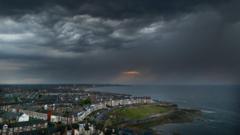Is the Heatwave Finally Over with Wind and Rain Sweeping the UK?

Understanding the UK Weather: From Extreme Heat to Mild Temperatures
The United Kingdom's weather is known for its unpredictable nature, often swinging from extremes in a matter of days. Recently, the country has witnessed a dramatic shift from a heatwave that saw record-breaking temperatures to a forecast of milder weather, accompanied by wind and rain. The Met Office has provided insights into this weather transition, highlighting the implications of these changes on daily life and health.
The Recent Heatwave: An Overview
On Saturday, the UK experienced its hottest day of the year, with temperatures soaring to 33.2°C (91.8°F) in Charlwood, near Gatwick. This extreme heat prompted the UK Health Security Agency (UKHSA) to issue an amber heat health alert, which warns that health and social care services may be significantly affected. The alert remains in effect until 09:00 BST on Monday, indicating the potential for increased demand on healthcare services and a rise in heat-related health issues, particularly among vulnerable populations such as the elderly or those with pre-existing health conditions.
What Constitutes a Heatwave?
The Met Office defines a heatwave based on the sustained temperature thresholds over a three-day period. The threshold varies across the UK, with:
- 25°C in the north and west
- 28°C in parts of southern England
During this recent heatwave, Suffolk was the first area to meet the criteria, marking a significant weather event for the region.
The Transition to Cooler Weather
As the heatwave subsided, Sunday brought a welcome relief with cooler temperatures. The country experienced a shift in weather patterns, leading to scattered showers and a drop in humidity. With temperatures around 27°C in southeast England, the air felt fresher as a brisk westerly wind swept across the region, bringing clouds and showers.
Forecast for the Week Ahead
The forecast indicates that the upcoming week will remain unsettled, characterized by a mix of sunshine and rain. Here’s what to expect:
- Monday: Fewer showers with more sunshine, providing a pleasant start to the week.
- Tuesday: Possible light and patchy rain, but generally stable weather.
- Wednesday: The arrival of muggy air from France, increasing the risk of heavy rain and thunderstorms in the evening.
- Thursday: The storms should clear, but expect wet and windy conditions in northern areas, while southern regions may experience warmer temperatures.
Impacts of Weather Changes on Daily Life
The drastic change in weather can have various impacts on daily life in the UK, particularly in transportation and public health.
Transportation Challenges
Extreme heat can lead to significant disruptions in public transport. For instance, during the recent heatwave, passengers on trains in south London were evacuated due to a train fault at Loughborough Junction. The lack of power and air conditioning during such high temperatures made it necessary for Thameslink and National Rail to pull resources from across Sussex and Kent to ensure the safety of passengers.
Health Considerations
With the amber heat health alert still in place, people are urged to take precautions. The heat can exacerbate existing health issues and lead to heat-related illnesses. To stay safe during high temperatures, consider the following tips:
- Stay hydrated: Drink plenty of water throughout the day.
- Avoid strenuous activities during peak heat hours.
- Wear loose, light-colored clothing to stay cool.
- Check on vulnerable family members and neighbors, especially the elderly.
Conclusion
The weather in the UK is a topic of constant discussion, with its ability to shift dramatically. From the recent heatwave to the cooler, more unsettled weather, it's essential for residents to stay informed and prepared. This transition not only affects day-to-day activities but also poses health risks that require attention. As we navigate through these fluctuations, understanding the patterns and their implications can help us adapt and respond effectively.
FAQs
What should I do during a heatwave?
During a heatwave, stay hydrated, avoid strenuous activities, and seek shade or air-conditioned spaces whenever possible. It's also vital to check on vulnerable individuals, such as the elderly or those with health conditions.
How does rain affect the temperature?
Rain can significantly lower temperatures by cooling the air and increasing humidity. Following a rain event, the atmosphere often feels fresher and more comfortable, especially after a period of extreme heat.
What is the difference between an amber and a red heat alert?
An amber alert indicates that health services may be significantly affected by high temperatures and that some vulnerable people may experience health issues. In contrast, a red alert signifies a more severe threat to life and health, suggesting that the heat is extreme and that everyone, not just vulnerable groups, is at risk.
As we adapt to the ever-changing UK weather, how do you prepare for extreme temperature fluctuations? #UKWeather #Heatwave #WeatherForecast
Published: 2025-06-22 13:30:15 | Category: technology



